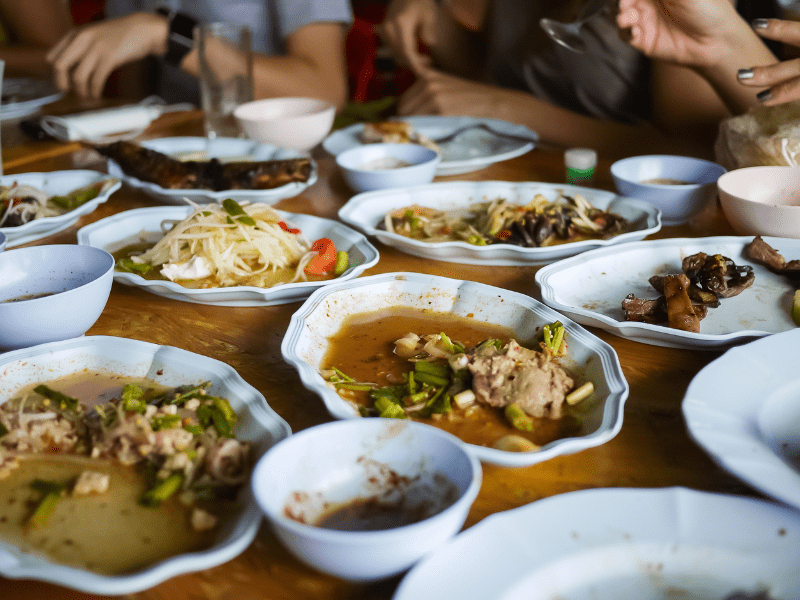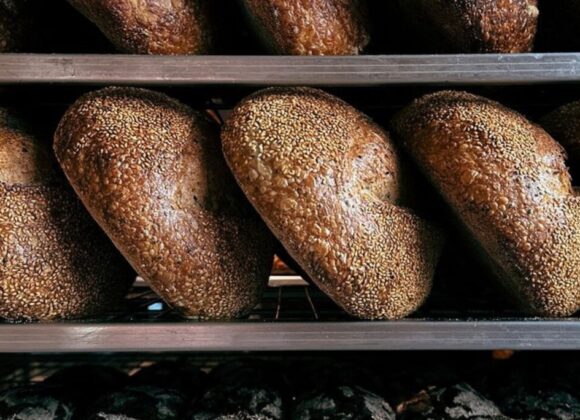Straty i marnotrawstwo żywności są problemem zauważanym w skali światowej od wielu lat. Zgodnie z definicją zaproponowaną przez Organizację Narodów Zjednoczonych ds. Wyżywienia i Rolnictwa (FAO), za „straty i marnotrawstwo żywności” (Food Loss and Waste – FLW) uważa się zmniejszenie ogólnej masy żywności, która była przeznaczona do spożycia przez ludzi.
Obejmuje ona ilość żywności, która początkowo była wyprodukowana na cele konsumpcyjne, jednak ostatecznie uległa naturalnym ubytkom masy (np. wysychaniu), zepsuciu lub została wykorzystana w innym celu (np. do produkcji biopaliwa, kompostu, pasz itd.). Do strat i marnotrawstwa żywności nie wlicza się natomiast części niejadalnych (np. kości, łupiny itd.) oraz surowców i produktów pierwotnie wytworzonych na cele niekonsumpcyjne (np. pasza, biokomponenty, bioenergia). W definicji FAO wyróżniono pojęcie marnotrawstwa rozumiane jako ubytki w masie żywności na poziomie handlu, gastronomii, gospodarstw domowych. Natomiast straty określono, jako zmniejszenie masy żywności w pierwszych ogniwach łańcucha żywnościowego, tj. produkcja podstawowa, przetwórstwo.
Marnotrawstwo żywności dotyczy każdego ogniwa tzw. łańcucha żywnościowego i niezależnie od etapu, którego dotyczy, zawsze związane jest z negatywnymi skutkami dotyczącymi środowiska, społeczeństwa, czy ekonomii. Według raportu Organizacji Narodów Zjednoczonych do spraw Wyżywienia i Rolnictwa z roku 2011 [3], w pierwszej dekadzie XXI wieku rocznie na świecie marnowane było około 1/3 żywności nadającej się do spożycia przez ludzi. Uwzględniając globalną masę produkowanej żywności, było to ok. 1,3 miliarda ton rocznie. W zależności od źródła danych szacuje się, że na poziomie Unii Europejskiej usługi gastronomiczne są odpowiedzialne za ok. 12% [4] – 14% [6] zmarnowanej żywności. Ostatnie badania przeprowadzone w Polsce wykazały, że co roku w Polsce marnuje się ponad 4,8 mln ton żywności. Uzyskane wyniki wskazują, że najwięcej żywności (60%) marnują konsumenci w gospodarstwach domowych. Szacuje się, że polska branża gastronomiczna była odpowiedzialna za 1,17% zmarnowanej żywności. Autorzy badań podkreślili jednak, że w tym ogniwie łańcucha żywnościowego, szacunki mogą być zaniżone ze względu na problemy z gromadzeniem danych pierwotnych i nieuwzględnieniem m. in. zakładów gastronomicznych poniżej 10 osób, punktów gastronomicznych, usług cateringowych [5].
Przyczyny marnowania żywności w zakładach gastronomicznych
Do marnotrawstwa w zakładach gastronomicznych dochodzi na wszystkich etapach obrotu żywnością, tj. od magazynowania surowców/półproduktów, do ekspedycji gotowych dań na sali konsumenckiej. Oczywiście, poziom zjawiska różni się w zależności od typu zakładu, przyjętej organizacji funkcjonowania, jak też zachowań i preferencji konsumentów korzystających z usług. Badania przeprowadzone w Polsce dotyczące gastronomii hotelowej wskazały, że najwięcej żywności marnowanej było w dziale ekspedycyjnym, tj. w bufecie na sali konsumenckiej oraz w postaci resztek talerzowych. Stwierdzono, że ok. 3/4 zmarnowanej w hotelach żywności pochodziło właśnie z tego działu. Przy czym znaczną część stanowiły tzw. resztki talerzowe pozostawione przez konsumentów na talerzach [9]. Także dane zagraniczne wskazują, że w branży gastronomicznej, znaczną część marnowanej żywności stanowią resztki talerzowe. Na przykład, w szwedzkich szpitalach resztki talerzowe stanowiły 42% masy zmarnowanej żywności [2], a w malezyjskich szpitalach oszacowano ich udział na 47,5% [8]. Należy podkreślić, że masa powstających resztek talerzowych jest związana z formą obsługi konsumentów. Serwowanie posiłków w postaci bufetu samoobsługowego (tzw. szwedzki stół), kiedy oferowana jest nieograniczona ilość żywności, a cena jest stała, są tymi czynnikami, które stymulują konsumentów do nakładania na talerz większej ilości niż są w stanie skonsumować [7]. W przedstawionym aspekcie, jednym z kluczowych elementów, na który powinna zostać zwrócona większa uwaga jest dostosowanie wielkości serwowanej porcji do preferencji konsumentów. Tymczasem, np. w Stanach Zjednoczonych wielkość oferowanych porcji systematycznie wzrasta, co wykorzystywane jest w działaniach marketingowych zakładów gastronomicznych. Określono, że amerykańscy konsumenci zostawiają 17% potraw, które nabywają w zakładach gastronomicznych [10].
Kolejnym problemem, z którym mierzą się zakłady gastronomiczne typu otwartego, mającym wpływ na poziom marnotrawstwa żywności jest nieprzewidywalny popyt. Wyrzucanie żywności w zakładach gastronomicznych z powodu przygotowywania zbyt dużej ilości posiłków jest częstym zjawiskiem. Oczywiście, w większości przypadków przygotowany nadmiar potraw jest przechowywany w temperaturze chłodniczej do dnia następnego. Jednak często wskazywaną praktyką jest też wyrzucanie niewydanych dań, których nie można przechowywać lub wykorzystać do przygotowania innej potrawy. Uważa się, że produkcja żywności w dużych ilościach minimalizuje koszty, ale w rzeczywistości powoduje więcej odpadów w porównaniu z przygotowywaniem na zamówienie lub gotowaniem małych partii [10]. Problem z oszacowaniem niezbędnej liczby porcji jest szczególnie częsty w obiektach, w których dania wydawane są w systemie samoobsługowym.

fot. pixabay
Wskazywaną przyczyną marnotrawstwa żywności w gastronomii jest także przeoczenie daty ważności produktów spożywczych. Według badań przeprowadzonych w polskich zakładach gastronomicznych [1] prawie połowa respondentów zatrudnionych w zakładach gastronomicznych wskazała, że “od czasu do czasu” produkty spożywcze w ich miejscu pracy marnowane są właśnie z tego powodu.
Marnotrawstwo żywności w gastronomii może też być konsekwencją nieuwzględnienia preferencji konsumentów, zwłaszcza dzieci w szkołach, względem jakości oferowanych dań. W przypadku żywienia szkolnego kluczowe są także liczba i czas zaplanowanych przerw obiadowych. W wielu szkołach podstawowych w dużych aglomeracjach, dzieci nie mają odpowiedniego czasu na konsumpcję posiłków serwowanych w stołówkach szkolnych.
Innymi podawanymi przyczynami marnotrawstwa żywności w gastronomii, są: nabywanie surowców/produktów o niskiej jakości, niewłaściwe warunki przechowywania żywności, błędy podczas produkcji, brak pomysłów na wykorzystanie surowców/produktów będących w nadmiarze.
Ograniczenie marnotrawstwa żywności w sektorze usług gastronomicznych jest dużym wyzwaniem, związanym m. in. ze skomplikowanym i długim procesem produkcyjnym oraz trudnościami w oszacowaniu popytu.
Jedną z możliwych aktywności, podejmowanych już przez niektóre zakłady gastronomiczne, jest sprzedaż potraw po niższej cenie pod koniec dnia, kiedy wiadomo, że nie zostaną skonsumowane (np. w ramach aplikacji „Too Good To Go”). Możliwe jest także przekazywanie bezpiecznych, pełnowartościowych produktów do organizacji pomocowych, dla osób potrzebujących. Wymaga to jednak podpisania umowy i dobrej koordynacji.
Literatura:
1. Bilska, B., Tomaszewska, M., Kołożyn-Krajewska, D. (2020b). Managing the risk of food waste in foodservice establishments. Sustainability, 12, 2050.
2. Eriksson, M.; Malefors, C.; Bergström, P.; Eriksson, E.; Persson Osowski, C. Quantities and Quantification Methodologies of Food Waste in Swedish Hospitals. Sustainability, 2020, 12, 3116. https://doi.org/10.3390/su12083116.
3. FAO (2011). Global food losses and food waste – Extent, causes and prevention. Pobrane z http://www.fao.org/docrep/014/mb060e/mb060e00.pdf. (dostęp 15.08.2021).
4. FUSIONS (2016). Estimates of European food waste levels. Pobrane z https://www.eu-fusions.org/phocadownload/Publications/Estimates%20of%20European%20food%20waste%20levels.pdf (dostęp:05.05.2021)
5. Łaba, S.; Bilska, B.; Tomaszewska, M.; Łaba, R.; Szczepański, K.; Tul-Krzyszczuk, A.; Kosicka-Gębska, M.; Kołożyn-Krajewska, D. Próba oszacowania strat i marnotrawstwa żywności w Polsce. Przemysł Spożywczy, 2020, 74, 10–18
6. Monier, V., Mudgal, ,S., Escalon, V., O’Connor, C., Gibon, T., Anderson, G., Morton, G. (2010). Final Report – Preparatory Study on Food Waste Across EU 27. European Commission. [DG ENV-Directorate C]. BIO Intelligence Service, Brussels. Pobrane z https://ec.europa.eu/environment/eussd/pdf/bio_foodwaste_report.pdf (dostęp: 25.08.2021).
7. Priefer, C., Jörissen, J., Bräutigam, K.R. (2016). Food waste prevention in Europe– a cause-driven approach to identify the most relevantleverage points for action. Resources, Conservation and Recycling, 109, 155–165.
8. Razalli, N.H.; Cheah, C.F.; Mohammad, N.M.A.; Manaf, Z.A. Plate waste study among hospitalised patients receiving texture-modified diet. Nutr. Res. Pract, 2021, 15, 655-671.
9. Tomaszewska, M.; Bilska, B.; Kołożyn-Krajewska, D. Estimation of the scale of food waste in hotel food service—A case study. Sustainability, 2021, 13, 421.
10. Yahia, E.M., Mourad, M. (2019). Food waste at the consumer level. W: E.M. Yahia (red). Preventing food losses and waste to achieve food security and sustainability. 2019, Cambridge: Burleigh Dodds Science Publishing
Autorki tekstu: Tomaszewska Marzena (adiunkt w Katedrze
Technologii Gastronomicznej i Higieny Żywności w Instytucie Nauk
o Żywieniu Człowieka SGGW), Bilska Beata (adiunkt w Instytucie Nauk o Żywieniu Człowieka SGGW w
Warszawie).










 Młodszy specjalista ds. komunikacji marketingowej i PR.
Młodszy specjalista ds. komunikacji marketingowej i PR.


 Absolwent Uniwersytetu Warszawskiego oraz Szkoły Głównej Gospodarstwa Wiejskiego. W branży HoReCa od ponad 10 lat. Przez lata związany z Grupą Trip, Sobienie Królewskie Golf and Country Club oraz restauracją Florentin w Warszawe.
Absolwent Uniwersytetu Warszawskiego oraz Szkoły Głównej Gospodarstwa Wiejskiego. W branży HoReCa od ponad 10 lat. Przez lata związany z Grupą Trip, Sobienie Królewskie Golf and Country Club oraz restauracją Florentin w Warszawe. Absolwentka Wydziału Architektury Politechniki Warszawskiej na kierunku Architecture for Society of Knowledge oraz Komunikacji Wizualnej na Politecnico di Milano. Specjalistka od budowania nastroju. Doświadczenie zdobywała w kraju i zagranicą podczas licznych warsztatów międzynarodowych (Sevilla, Lizbona, Florencja), stypendium na La Sapienza (Rzym) oraz pracując m.in. w Carmi e Ubertis i ADM Milano.
Absolwentka Wydziału Architektury Politechniki Warszawskiej na kierunku Architecture for Society of Knowledge oraz Komunikacji Wizualnej na Politecnico di Milano. Specjalistka od budowania nastroju. Doświadczenie zdobywała w kraju i zagranicą podczas licznych warsztatów międzynarodowych (Sevilla, Lizbona, Florencja), stypendium na La Sapienza (Rzym) oraz pracując m.in. w Carmi e Ubertis i ADM Milano.








 Menedżer z wieloletnim doświadczeniem w branżach kosmetycznej, spożywczej, dziecięcej. W trakcie swojej kariery związany z firmami takimi jak: L’Oreal, Samsung, Danone-Nutricia, Unilever. W ciągu swojego życia zawodowego odpowiadał między innymi za rozwój sprzedaży i contentu eCommerce w Polsce i krajach Europy Środkowo-Wschodniej.
Menedżer z wieloletnim doświadczeniem w branżach kosmetycznej, spożywczej, dziecięcej. W trakcie swojej kariery związany z firmami takimi jak: L’Oreal, Samsung, Danone-Nutricia, Unilever. W ciągu swojego życia zawodowego odpowiadał między innymi za rozwój sprzedaży i contentu eCommerce w Polsce i krajach Europy Środkowo-Wschodniej. 

























































